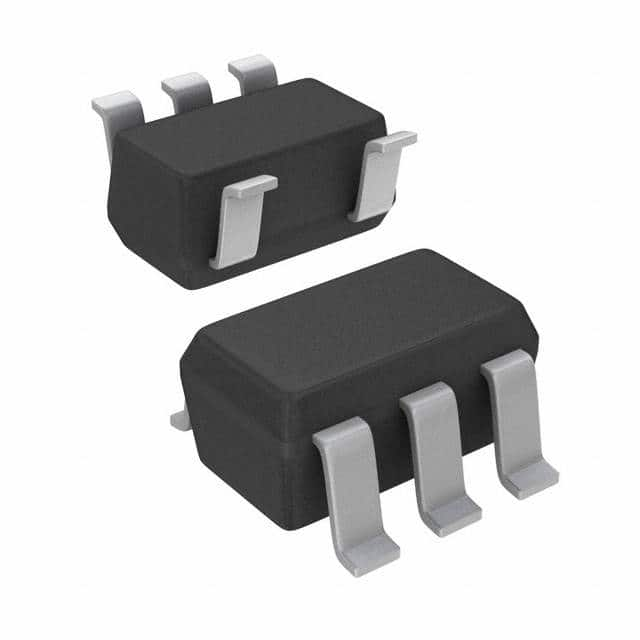Xem thông số kỹ thuật để biết chi tiết sản phẩm.

SN74LVC1G14DBVT
Product Overview
- Category: Integrated Circuit (IC)
- Use: Logic Gate
- Characteristics: Schmitt Trigger Inverter
- Package: SOT-23-5
- Essence: Single Gate Inverter
- Packaging/Quantity: Tape and Reel, 3000 pieces per reel
Specifications
- Supply Voltage Range: 1.65V to 5.5V
- Input Voltage Range: -0.5V to VCC + 0.5V
- Output Voltage Range: 0V to VCC
- Maximum Operating Frequency: 100 MHz
- Propagation Delay: 3.9 ns (typical)
- Input Capacitance: 2 pF (typical)
- Operating Temperature Range: -40°C to 85°C
Detailed Pin Configuration
The SN74LVC1G14DBVT has a total of five pins:
- GND (Ground): Connected to the ground reference potential.
- IN (Input): The input signal is applied to this pin.
- VCC (Power Supply): Connected to the positive supply voltage.
- OUT (Output): The inverted output signal is available at this pin.
- NC (No Connection): This pin is not connected internally and can be left unconnected.
Functional Features
- Schmitt Trigger: The SN74LVC1G14DBVT incorporates a Schmitt trigger input, which provides hysteresis and improves noise immunity.
- Inverter Function: It acts as an inverter, producing the logical complement of the input signal at the output.
- Wide Supply Voltage Range: The IC operates over a wide supply voltage range, making it suitable for various applications.
- High-Speed Operation: With a maximum operating frequency of 100 MHz, it can handle high-speed digital signals.
- Low Power Consumption: The IC is designed to consume low power, making it energy-efficient.
Advantages and Disadvantages
Advantages: - Compact Size: The SOT-23-5 package allows for a small footprint, making it suitable for space-constrained applications. - Wide Supply Voltage Range: It can operate over a wide range of supply voltages, providing flexibility in different systems. - Schmitt Trigger Input: The built-in Schmitt trigger enhances noise immunity and signal integrity.
Disadvantages: - Single Gate: The SN74LVC1G14DBVT is a single gate inverter, limiting its functionality to simple logic operations. - Limited Output Current: The output current capability may not be sufficient for driving highly capacitive loads.
Working Principles
The SN74LVC1G14DBVT is based on CMOS (Complementary Metal-Oxide-Semiconductor) technology. It utilizes MOSFET transistors to implement the inverter function. The Schmitt trigger input ensures that the output transitions occur at well-defined voltage levels, even in the presence of noise or slow input signals.
When the input voltage is below a certain threshold, the output is high. Conversely, when the input voltage exceeds another threshold, the output switches to a low state. This hysteresis property prevents false triggering and improves noise immunity.
Detailed Application Field Plans
The SN74LVC1G14DBVT finds applications in various fields, including:
- Digital Systems: It is commonly used in digital systems for logic level conversion, signal inversion, and buffering.
- Communication Systems: The IC can be employed in communication systems for waveform shaping and signal conditioning.
- Industrial Control: It is suitable for industrial control applications where reliable and noise-immune logic functions are required.
- Consumer Electronics: The compact size and low power consumption make it ideal for portable devices, such as smartphones and tablets.
- Automotive Electronics: The IC can be utilized in automotive electronics for signal processing, sensor interfacing, and control systems.
Detailed and Complete Alternative Models
- SN74LVC1G04DBVR: Single Gate Inverter with Open-Drain Output
- SN74LVC1G08DBVR: Single Gate AND Gate
- SN74LVC1G32DBVR: Single Gate OR Gate
- SN74LVC1G86DBVR: Single Gate XOR Gate
- SN74LVC1G125DBVR: Single Gate Buffer/Driver with 3-State Output
These alternative models offer similar functionality to the SN74LVC1G14DBVT but may have different pin configurations or additional features.
Word count: 540 words
Liệt kê 10 câu hỏi và câu trả lời thường gặp liên quan đến ứng dụng SN74LVC1G14DBVT trong giải pháp kỹ thuật
Sure! Here are 10 common questions and answers related to the application of SN74LVC1G14DBVT in technical solutions:
Q1: What is SN74LVC1G14DBVT? A1: SN74LVC1G14DBVT is a single Schmitt-trigger inverter gate IC, commonly used in digital logic circuits.
Q2: What is the operating voltage range of SN74LVC1G14DBVT? A2: The operating voltage range is typically between 1.65V and 5.5V.
Q3: What is the maximum output current of SN74LVC1G14DBVT? A3: The maximum output current is around 32mA.
Q4: Can SN74LVC1G14DBVT be used as a level shifter? A4: Yes, it can be used as a level shifter to convert signals between different voltage levels.
Q5: What is the propagation delay of SN74LVC1G14DBVT? A5: The typical propagation delay is around 4.5ns.
Q6: Is SN74LVC1G14DBVT suitable for high-speed applications? A6: Yes, it is suitable for high-speed applications due to its fast switching speed.
Q7: Can SN74LVC1G14DBVT drive capacitive loads? A7: Yes, it can drive small capacitive loads up to a certain limit.
Q8: Does SN74LVC1G14DBVT have built-in ESD protection? A8: Yes, it has built-in ESD protection to safeguard against electrostatic discharge.
Q9: Can SN74LVC1G14DBVT operate in harsh environments? A9: It is not specifically designed for harsh environments, but it can operate within the specified temperature and voltage ranges.
Q10: What are some typical applications of SN74LVC1G14DBVT? A10: Some typical applications include signal conditioning, level shifting, clock generation, and general-purpose digital logic circuits.
Please note that these answers are general and may vary depending on specific datasheet specifications and application requirements.

